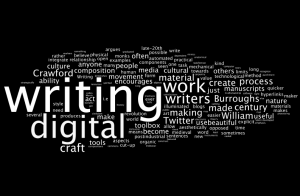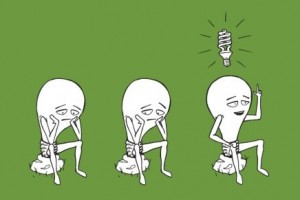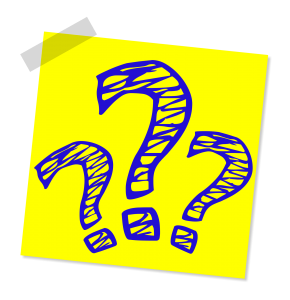
The year is 2017, and it often feels impossible to step outside your door and not see people glued to their electronic devices with fingers blazing, typing away. Following the Digital Revolution of the 1970’s, on-screen writing has become integrated into everyday life ranging from social media platforms like Twitter to academic databases used by education institutions worldwide. This post itself was assigned in an English course dedicated to educating students how to best understand and utilize digital writing. Writing digitally opens new avenues for writers through more literary freedom, multimodality and mass collaboration in a manner in which traditional on-paper literature lacked. However, despite its innate advantages, there is an argument that digital writing takes away from (or even forgoes) some of the foremost literary principles attributed to on-paper writing. Nonetheless, Digital writing has and will continue to be an increasingly ingrained part of the 21st century’s cultural context. As a result, being capable of effectively writing online is necessary for navigating literacy of the future both formally and informally.
The Rise of Digital Writing

http://image.slidesharecdn.com/edulearn15lairecasteleynmottartdigitalmediawritingtoolsthetheoryofwritingcurriculatherealityofteachi-150703130637-lva1-app6892/95/edulearn-15-laire-casteleyn-mottart-digital-media-writing-tools-the-theory-of-writing-curricula-the-reality-of-teaching-practices-2-638.jpg?cb=1435928823
Following the rise of technology, digital writing has become more and more prevalent in society’s social, educational and professional spheres. In the United States alone, 1.96 billion people write digitally via media sites like Twitter and Facebook, accounting for an astonishing 81 percent of the population. It is clear to connect the statistics to the relevance digital writing has within our day to day social lives. As well as its prevalence in informal literature, digital writing also plays a massive role in the educational and professional place. Traditionally, professional and academic environment was characterized by paper, pen, and piles of written work. However now so more than ever, students are writing through digital educational platforms like Moodle while academics post scholarly articles for databases online. Troy Hicks, Dànielle Nicole DeVoss, Elyse Eidman-Aadahl in their book, “Because Digital Writing Matters: Improving Student Writing in Online and Multimedia Environments” emphasizes the importance of teaching digital writing in education. Hicks offers that, “[because] young people today have an unprecedented level of access to a wider range of content and connectivity than ever before, yet access does not ensure that reflection and learning take place. Student writers will need thoughtful and well-prepared teachers and mentor” (Hicks, 2). Within the contemporary workspace, digital writing manifests itself in policy legislation, promotional advertising, and public relation in which can be discussed collaboratively. Digital writing is a key component to the twenty-first-century lifestyle from working, socializing and schooling.
Advantages to Digital Writing

http://digitalwritingsu13.wikidot.com/
But how and why did digital writing become such an integral part of modern writing? Well, digital writing offers writers advantage tools that analog writing does not. One of the benefits of writing digitally is that it is multimodal. Writing on paper is typically one dimensional but writing online is multifaceted in its ability to engage an audience. Digital writing such as blogs and article posts, often feature pictures, hyperlinks, audio, and even video. This gives writers more ways to connect with readers across multiple mediums. In addition to granting increased freedom, digital writing opens the door for “mass-collaboration”. Digital writing can be easily accessed, assessed and critiqued by millions of people within the online community. This increased capacity for collaboration provides more avenues for writers to better develop their pieces than previously thought possible. Jen Rajchel’s article “Consider the Audience” argues that digital environments make for better writing by presenting “a broader dialogue among scholars and texts” (Rajchel). Because every piece put online can reach a much larger audience, there is a greater obligation to provide thoughtful and in-depth content to them. As a result, the writer typically put more intent on producing high quality of work. Rajchel concludes that “When students [people] feel an increased level of investment in their projects and a heightened sense of responsibility to an actual audience, the work becomes less about grades and more about shaping their scholarship.” This is advantageous because digital writing simultaneously raises the standard of production while engaging author investment in the process of learning how to write.
How to Produce Quality Digital Writing

http://fashionablygeek.com/wp-content/uploads/2008/11/light-bulb-eureka.jpg
Much about writing effectively online revolves around finding an authentic tone to present to your audience. Writing off the paper allows for more literary freedom providing space for one’s voice as an author to better manifest itself. Pete Rorabaugh, an English professor at Kennesaw State University, wrote an article “Organic Writing and Digital Media: Seeds and Organs” further explaining how to develop an authentic tone when writing online. In order to create an organic voice while writing online, it’s best, to begin with, a stream of consciousness. The article encourages online authors to “write loosely” (Rorabaugh) for both explicit and creative writing pieces. Despite the common, the misconception that writing must follow a fixed, linear process, writing freely allows for smooth transitions being paragraphs and changes in thought. Writing loosely fosters more casual, organic tones of writing, and despite its potential to lack organization – format can be reevaluated and improved upon later in the re-drafting process. In the digital environment, Rorabaugh argues that there is no one way to go about the writing process. He identifies that “Each paragraph is an experiment, and comments in the digital space should focus on whether specific approaches are valuable, useful, or empty.” Freedom and creativity within the writing process lend themselves toward ensuring a piece reads as authentic.
In addition to “writing loosely”, if a piece is to genuinely read as organic, one’s writing process must be an interactive experience between the writer and the expected audience. This way your online piece can become the product of the collaborations within your online community. Pete Rorabaugh supports that this understanding is especially important when writing for digital environments as, “they rebuild ‘audience,’ expose the organic layers of a composition and invite participation in key stages along the way”(Rorabaugh). Digital writing pieces put emphasis on author-audience collaboration, as he explains “[the] growth [of a piece] is determined by the encouragement and critique of the community.” (Rorabaugh). Students should be taught that organic writing is less reliant of traditional ways of constructing a piece but rather on the collaboration of author and community. This approach allows for pieces to be better capable of connecting with audiences as organic writing.
Digital Writing V. Analog

https://pixabay.com/p-1421013/?no_redirect
Despite the tips offered in “Organic Writing and Digital Media: Seeds and Organs”, some argue that online writing will never be as organic as tradition analog literature. Writing online offers instant access to varied audiences, multimodal forms expression and greater collaboration within the writing process. However, there is concern that the digital tools meant to accommodate authors actually take away from their ability to write effectively. As a result, some argue that digital writing should not be gaining prominence in the education system. Kristen Purcell, Judy Buchanan, and Linda Friedrich, in their book “The Impact of Digital Tools on Student Writing and How Writing is Taught in Schools,” reveal some of the concern teachers across the nation have about digital writing. Digital writing is used universally among various platforms from texting to academia. They identified that because digital writing is present in so many facets of everyday life it presents, “an increasingly ambiguous line between ‘formal’ and ‘informal’ writing and the tendency of some students to use informal language and style in formal writing assignments” (Purcell, 2) Despite providing writer with a larger and more varied audience, digital writing requires more emphasis to be put on developing unique voice for various crowds. Some argue that digital tools make students less capable writer by doing too much of the work for them. Purcell, Buchanan and Friedrich also found that 46% of teacher believe digital tools, “make students more likely ‘write too fast and be careless”. Surveys in their book also reveal that “68% [of teachers] say that digital tools make students more likely… to take shortcuts and not put effort into their writing” (Purcell, 2) The efficiency of digital writing can be hindering to a student’s ability to engage in reading and writing longer pieces of literature. Some educators have adopted an understanding that digital literature takes away from the authenticity of writing. However, the National Commission on Writing: “The Neglected “R”: The Need for a Writing Revolution” (2003) disputes that this conservative approach to literature is limiting:
“in today’s complex, high-technology world, the importance of writing as a fundamental organizing objective of education is no less valid or practical. Writing, properly understood, is though on paper. Increasingly, in the information age, it is also though on screen, a richly elaborated, logically connect amalgam of ideas words, themes, images, and multimedia designs” – (The Neglected “R”, 13)
The future of writing directly correlates with the advancement of digital technology. In an ever technologically advancing society, digital writing is just as – if not more- valid a medium as analog writing. It is no coincidence that digital writing has assumed an increasing role in all levels of education. As a result, Troy Hick explains: “Teachers of writing have a crucial role in supporting students in understanding the complexities of communicating in a twenty-first-century world” (Hicks, 2) The versatility, reach and growing presences of digital writing cements its place within the academic sphere and the grander world at large.
My Experience with Digital Writing
My personal experiences align with research’s understanding that digital writing is deeply interwoven into the twenty-century-context. Every day I find myself utilizing digital writing in one form or another.
This semester I am taking a Writing in & for Digital Environments class. This course offers insight on techniques to make digital posts as impactful as possible such as those offered in Rorabaugh’s “Organic Writing and Digital Media: Seeds and Organs”. I am the Social Media and Marketing Chair for the Dickinson Octal A Capella Group and as such I am tasked with monitoring and managing our group’s online presences. Through social media sites like Facebook and Instagram, digital writing allows for my group to expand its presence both online and on campus. Not only do I use the tools provided by this course to aid my post for The Octals, they also help me navigate my own student blog: The Gauntlet. Before taking a class on digital writing I was not familiar with the multimodal aspect associated with blogs. Nor was I familiar with the capacity of mass-collaboration in online writing. Most of my writing as a student was limited to the classic five-paragraph essays of high school. When I first enter the class, the multimodality of digital writing seemed like another complex layer to navigate while the idea of millions of people having access to my work was terrifying. However, Writing in & for Digital Environments has molded my understanding of both, as tools to further progress my writing throughout my academic career as a “Social Innovation and Entrepreneurship” major. Furthermore, my digital writing class prepares me for my future career outside of college. In the future, I intend on working in advertising and marketing. Since taking Writing in & for Digital Environments, I recognize digital writing will continue to shape my life in social, academic and professional aspects.
Sources
Purcell, Kristen, et al. “The Impact of Digital Tools on Student Writing and How Writing Is Taught in Schools.” Pew Research Center: Internet, Science & Tech, 15 July 2013, www.pewinternet.org/2013/07/16/the-impact-of-digital-tools-on-student-writing-and-how-writing-is-taught-in-schools/.
Rajchel, Jen, et al. “Consider the Audience.” Web Writing: Why and How for Liberal Arts Teaching and Learning. Eds. Jack Dougherty and Tennyson O’Donnell. Trinity College ePress edition, 2014. EBook. 29 October 2017, https://epress.trincoll.edu/webwriting/chapter/rajchel/
The Nation Commission on Writing, et al. “National Writing Project.” The Neglected “R”: The Need for a Writing Revolution – National Writing Project, The College Board, Apr. 2003, www.nwp.org/cs/public/print/resource/2523.
Project, National Writing, et al. “Because Digital Writing Matters: Improving Student Writing in Online and Multimedia Environments.” Alibris, Mar. 2015, www.alibris.com/Because-Digital-Writing-Matters-Improving-Student-Writing-in-Online-and-Multimedia-Environments-National-Writing-Project/book/27744760.
Purcell, Kristen, et al. “The Impact of Digital Tools on Student Writing and How Writing Is Taught in Schools.” Pew Research Center: Internet, Science & Tech, 15 July 2013, www.pewinternet.org/2013/07/16/the-impact-of-digital-tools-on-student-writing-and-how-writing-is-taught-in-schools/.
Rorabaugh, Pete. et al. “Organic Writing and Digital Media: Seeds and Organs.” Hybrid Pedagogy, 21 June 2012, www.digitalpedagogylab.com/hybridped/organic-writing-and-digital-media-seeds-and-organs/.
